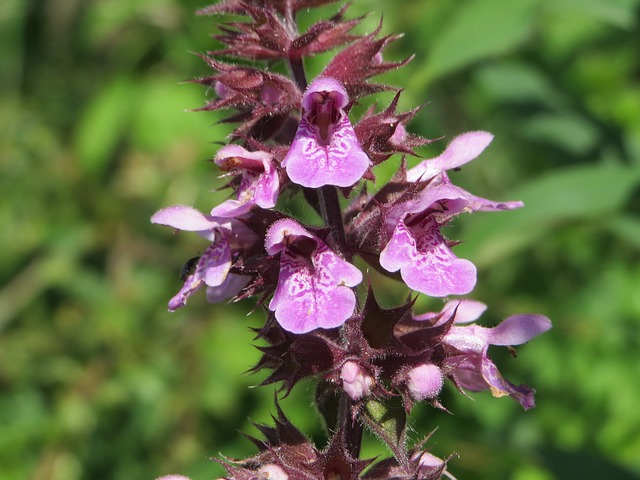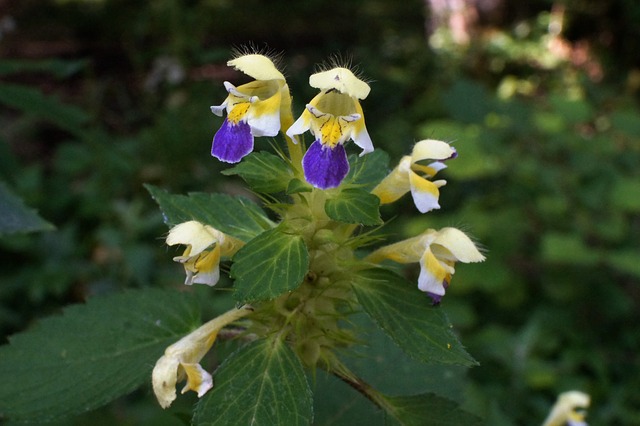Large-flowered Hemp-nettle (Galeopsis speciosa Mill.)
 |  |  |  |  |
 |  |
Hemp-nettle (Galeopsis spp.) are annual herbaceous plants, growing 15–100 cm tall, and are considered common weeds. Their stems are branched, erect, four-angled, thickened at the nodes, and covered with glandular, rough, spreading bristles that feel prickly to the touch. The leaves are ovate-lanceolate or rhombic in shape, toothed along the edges, and arranged oppositely.
The flowers are bisexual with a two-lipped corolla and a tubular bell-shaped calyx. Depending on the variety, the flowers can be reddish-violet to purple-red. The upper lip of the flower is yellow, while the lower lip has a bright purple spot. Flowers are arranged in groups of 6 to 10 in the axils of the upper leaves. The plant begins flowering in midsummer and continues until the first frosts. The fruit is a dry nutlet that splits into four flat nutlets.
Both the flowers and fruits of hemp-nettle are toxic. The seeds can remain viable in the soil for up to 15 years. One plant can produce up to 8,000 seeds. Reproduction occurs by seeds.
Although several species of hemp-nettle grow locally, they all possess roughly equivalent medicinal properties and are used similarly in traditional medicine.
For medicinal purposes, the aerial parts of the plant are harvested: flowers, stems, and leaves. Stems are cut close to the ground during the flowering period, before seed formation. The harvested material is dried in bundles with the flower heads facing downwards, in well-ventilated, shaded areas. The dried drug is stored in ventilated containers (such as paper bags) for up to 2 years.
The aerial parts of hemp-nettle contain a significant amount of silica (about 10%), mucilage (<10%), iridoids (galipirozide, garpahide, 6-deoxygarpahide, glucoside, 9-acetylgarpahide), resins, bitter substances, wax compounds, flavonoids (0.9% scutellarin), sterols, saponins, tannins, fats (<45%), essential oils, salicylic acid, caffeic acid, and other compounds.
MEDICINAL IMPORTANCE
According to research from the Siberian State Medical University, which studied hemp-nettle from a pharmaceutical perspective, this plant can serve as a source of silicon in the treatment of pulmonary tuberculosis. Silicon dioxide helps normalize, strengthen, and increase the elasticity of connective tissues and lung epithelial tissues, as well as internal secretion glands. Silicon also enhances the body’s immune defense functions.
Silicon compounds aid in eliminating toxins and metabolites from the body through urine. Thanks to the presence of silicon salts and saponins in hemp-nettle, the aerial parts of the plant can be used as an expectorant to promote sputum discharge.
In folk medicine, hemp-nettle is used much more broadly. Infusions are applied to treat respiratory diseases, bronchial catarrh, asthma, and, in combination with Tussilago farfara (coltsfoot), tuberculosis.
The alcoholic extract exhibits a good therapeutic effect in urinary tract inflammation.
Due to its anti-inflammatory and antispasmodic properties, hemp-nettle is used in the form of infusions and decoctions to treat various digestive tract disorders: stomach ulcers, colitis, chronic pancreatitis, and liver diseases. The leafy parts of the plant are applied as a tonic in cases of anemia, after severe infectious diseases, and to strengthen immunity. The aerial parts are also used in mixtures as a blood-purifying component.
In Bulgaria, the aerial parts of hemp-nettle are used to treat oncological diseases, including leukemia.
Externally, hemp-nettle is applied to treat neurodermatitis, furunculosis, psoriasis, eczema, and panaritium, through phytocompresses and medicinal baths.

Common Hemp-nettle (Galeopsis tetrahit L.)
